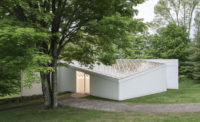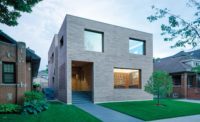Seoul
It's not exactly a house, nor entirely a gallery, but it does have a wine bar'and might best be described as 'semi-public.' That said, Steven Holl is comfortable with fluid, hybrid typologies, having designed projects such as the Linked Hybrid complex in Beijing, which combines housing, retail, cinema, and recreation. But for the Daeyang Gallery and House, his first project in Korea, the New York architect also threw in an avant-garde music metaphor, a mathematical reference, and a hefty dose of the 'phenomenology' for which he is known. The result is a 10,700-square-foot compound that, despite its heavy-handed complexity, resonates with remarkable subtleties.
Built for the Daeyang Shipping Company to display its collection of art, which spans from ancient Korean artifacts to cutting-edge contemporary works, the project occupies a hilly site in a posh residential section of Seoul. It comprises three pavilions'a guest residence, an event space, and a reception area'that emerge from a reflecting pool on the roof of a sprawling, lower-level gallery.
As inspiration for the plan, Holl used a drawing he discovered in a John Cage book of a 1967 musical score by the Hungarian-Canadian composer Istv'n Anhalt. Holl followed the sketch to a tee: two rectangular-ish shapes in the upper-left and -right corners (which he used as the footprints of the events pavilion and guesthouse), pierced from below by a vaguely sword-shaped element (now the reception space with the wine bar). He recast the spaces in between as the building's reflecting pool. 'Music, in the form of the graphic of the score, was a heuristic device provoking the three-pavilion concept piercing the sheet of water,' Holl explains.
Before the heuristics begin, however, you drive into a stone-paved courtyard, then enter the building at the lower-level gallery. From a split-level foyer, you take steps down or go up ramps to traverse three pleasingly diverse gallery spaces that then lead to the pavilions upstairs. Throughout the project, 59 linear skylights, parallel but staggered irregularly, bring daylight inside. Many of the skylights are set in the reflecting pool, so light trickles through water before entering the galleries below and dancing across walls and floors. 'The skylights cutting through like [musical] staff lines allow sunlight to reconfigure the spaces daily and seasonally'as if the sun plays the music in light and space,' Holl says.
A similar sense of fluctuation applies to the spaces themselves. One set of stairs and ramps boomerangs up, through the reflecting pool, and then to the wine bar.Surrounded by a garden with stands of black bamboo, pines, and gingko trees, the glass-and-copper pavilions create mesmerizing reflections in the pool while offering shifting perspectives of landscape, water, and architecture.
Such visual effects are heightened by the pavilions' floor-to-ceiling, double-paned glass. Instead of mullions, Holl employed barely noticeable support fins for the glass, which creates an elegant look but required one of the flat, overhanging roofs to be cantilevered and steadied by piano wire.
Other Holl signatures make an appearance: a door that wraps into a corner, notched walls, and neo-constructivist lighting fixtures. (Like many Holl projects, the building is geothermally heated and cooled.) The architect also designed custom-made rugs, which abstract the Anhalt drawing in shades of mustard, green, and Matisse blue. He even created a sculptural mailbox.
But just when you start to feel overwhelmed by a sense of Gesamtkunstwerk, the building allows your eyes to regain focus. A restrained material palette'granite and concrete below, dark oak floors and reddish wood walls and ceilings on the pavilion level'tone things down. Muted details, such as curving feet for gallery railings and recessed lighting that almost disappears, further soften the pedantic blow.
Holl's buildings, and his readings of them, sometimes feel overwrought. Besides the Anhalt sketch, the Daeyang project ostensibly follows proportions based on the mathematical sequence 3, 5, 8, 13, 21, 34, 55'the Fibonacci series. Of course, math, music, and architecture have a long history of conspiring at some larger truth; Holl himself has taught a course at Columbia called 'The Architectonics of Music.' But as an intellectual exercise, that triumvirate feels nearly exhausted'in the Seoul project, it risks becoming a contrivance, an overabundance of concepts. Still, that ought not take away from Holl's experiential accomplishment here. Cutting through the rhetorical clutter, one finds a building that is, in reality, full of sublime moments.
Aric Chen is a Beijing-based writer and curator.
Seoul Man
Designing houses has always been a critical part of his practice, says Holl: 'Architecture isn't about size. It's about the ideas, the materials, the spatial energy invested in it. Some of the greatest works of architecture are quite small. Just look at Corbusier's Heidi Weber Pavilion in Zurich.' He admits, though, that 'my business manager always complains about us losing money on small projects.'Steven Holl titled his latest book Scale in recognition of the remarkable range in size of his recent work, from a 650-square-foot gallery in Dutchess County, New York, to a 3.3 million-square-foot, mixed-use complex under construction in Chengdu, China. The book (published by Lars M'ller) is 5 by 7 inches, the same as the notebooks in which he has been sketching watercolors for the past 30 years. The title also refers to the scale composers use in their art and the role music has played in his body of work. 'The book is the size of your hand,' says the architect, who compares the musical staff to our five fingers. Showing the impact of the human hand on his buildings is important to Holl, and he tries to design door pulls and light fixtures in addition to the architecture. 'Details are the strange and interesting remarks we make in our work,' he says. 'The intensity of architecture is really felt at the level of the detail.'
Music has served as a direct reference in two of Holl's previous built projects: the Sarphatistraat Offices in Amsterdam (2000) and the Stretto House in Texas (1991). But the music that inspired the Daeyang Gallery and House is different, he says, because it was never played: 'We found a way of playing it, though, with light.'
Holl says he struggled with the Daeyang project, in part because the program was vague at first. He looked for ideas in Korean ceramics, but didn't find the right spark: 'This is my first project in Korea. It's a very intense place with a strong culture and rich heritage of art and design.'
Asked about winning the American Institute of Architects' Gold Medal this year, Holl laughs. 'I feel I'm still getting started!' Then he adds, 'Doing experimental work is still important to me. Teaching is still important to me.' So even though he is working on projects all over the world and at scales large and small, he tries to retain the same process and attitude toward creating architecture. —
Completion Date: April 2012
Gross square footage: 10,700 square feet
Total construction cost: withheld
PeopleOwner: Daeyang Shipping Corp.
Architect:
Personnel in architect's firm who should receive special credit:
Local Architect(s):
Engineer(s):
Consultant(s): Photographer(s): Iwan Baan |
Products
Structural system Pavilion level: Steel
Exterior cladding
Metal/glass curtain wall:
Typical Glazing: Rainscreen: see metal panel
Roofing
Windows
Glazing Skylights: OKALUX(GER),42mm / Interpane(GER), 30.76mm Other: (Lighting Cover)Thick 3.85mmOpalica, SCHOTT(GER)
Doors Metal doors: Steel door, JANSEN(GER) Wood doors: Solid core wood door/ Ash, Cabreuva Vermelha wood finish Sliding doors: Thick 20mmAcid etched translucent glass door
Hardware Exit devices:Beijing, OLIVARI(ITA) Pulls: Custom made cast bronze door pull @ gallery entrance, custom 3d milled wood door handle @ pavilion 1 library Other special hardware: Custom made
Interior finishes Cabinetwork and custom woodwork: Custom made Wall coverings: 14mm Cabreuva Vermelha, Listone Giordano(ITA) Floortile: Thick 24mm Black Granite, Flamed Carpet: Designed by Steven Holl, Custom made Gallery Flooring: Thick 30mm Grey Granite, Flamed Pavillion Flooring: 9.5mm stained Oak Flooring, Listone Giordano(ITA)
Special interior finishes unique to this project:
Furnishings
Lighting LED Lighting: GE Lighting Exterior: Custom lighting fixtures designed By Steven Holl architects
Dimming System or other lighting controls:
Plumbing
Other unique products that contribute to sustainability: Gallery floor Heating&Cooling: Eco enerdigm(KOR+ITA) |















